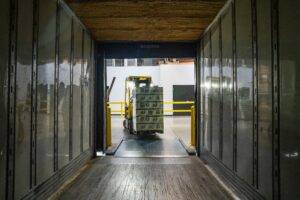Shippers continue to overlook intermodal freight transportation when establishing strategies for freight and logistics because they do not have enough information about the benefits of this mode of transportation for freight. With the assistance of an intermodal shipping and logistics provider, it is possible to gain a deeper comprehension of the influence that intermodal services have on the transportation of goods along supply chains. It is a wonderful technique to boost the efficiency of transportation to send goods via a combination of several modes of transport at the same time.
It is being viewed as a potential alternative to conventional modes of transportation due to the several advantages it provides to shippers in terms of its price, capacity, security, and lifespan. It is imperative that shippers have a thorough understanding of the advantages of intermodal shipping in order to ensure that the shipping process is as efficient as possible. When considering their alternatives, shippers will have a difficult time avoiding the consideration of multimodal transportation in light of its benefits.
In this post, we will discuss the benefits of utilizing a variety of means of transportation. In addition, we will discuss what intermodal transportation is and why it is beneficial for businesses that carry goods.
What is Intermodal?
The movement of freight from the shipper to the receiver using two or more modes of transportation is referred to as intermodal transportation. The shipment of goods is accomplished with the use of standardized intermodal containers that are able to be transferred without any disruption between various modes of transportation such as ships, trucks, and trains. When transferring between modes of transportation, the freight in this method of transportation is not handled.
Domestic and international shipments are the two categories that make up the intermodal shipping category. The fact that containers used for international intermodal transport can be transferred between ships, trucks, and trains is the primary distinction between those used for domestic intermodal transport and those used for international transport. In contrast, domestic intermodal containers are only traded between rail and trucks; they are never placed onto ships. Instead, they are only traded between rail and vehicles.
When to Rely on Different Forms of Transportation
Shippers need to be aware of the circumstances in which it is prudent to utilize intermodal shipping in order to fully take advantage of the benefits that intermodal transport has to offer. The following examples will illustrate these points:
1. Long-Distance Shipping
Shippers can experience lower transportation costs when shipping over large distances using intermodal, with an ideal distance of at least 700 miles. This is because intermodal shipping delivers cost savings that can be passed on to shippers.
2. High Freight Volume
Shippers who are interested in shipping huge volumes of freight can also benefit from adopting intermodal transportation because of the capacity advantage and the efficiency with which it moves freight.
3. Non-urgent Shipments
Time spent switching containers from rail to truck and back again is a major factor in why intermodal transportation durations are longer than truckload. Who’s why companies that can’t be flexible with their delivery dates shouldn’t use intermodal shipping.
4. Shipping High-Value Freight
Due to the additional time required to transfer containers from rail to truck and vice versa, transit times for intermodal shipments are often longer than those for truckload shipments. Therefore, shippers who do not have a delivery schedule that can be adjusted would be better off avoiding the intermodal shipping option.
Advantages of Intermodal Freight
Shipping via intermodal can offer benefits for a wide range of important core transportation concerns, as well as a variety of other core transportation concerns. The following is a list of advantages that come with using intermodal transportation.
1. Reduced Expenditures
When the operational benefits of rail and truckload shipping are combined, the result is a financial advantage as well as increased efficiency. A shipper can enjoy enhanced flexibility, improved service, and reduced costs when they transport their goods by rail for the long haul phase of their journey and by truck for the dray transfers. When compared to truck rates, intermodal rates are more competitive when a freight lane has fewer drayage costs connected with it.
2. Big Capacity
Because of the way that intermodal operations flow, it is possible for intermodal to give a shipper with a large number of truckload solutions relatively quickly. Drayage distances are often less than one hundred miles, which enables a single driver to make many turns carrying various loads to an intermodal ramp. When compared to the truckload, which typically permits a driver to travel miles before receiving a fresh load, this allows for a greater turnaround time. This may be a benefit at a time when a lack of drivers is continuing to cause problems.
3. Visibility
It is a common myth that visibility decreases as soon as a container is loaded onto a railway, which causes people to overlook the truth that intermodal freight transportation can offer increased visibility. This point is usually overlooked. During the loading procedure, each container is scanned as it enters an intermodal ramp and is then placed on the railcar of the train. Tracking will take place from the origin-to-destination intermodal ramps, and it will need to be reviewed once more during the process of leaving the outgate.
4. Reliability
The use of intermodal transportation offers a solution that is not only secure but also safe, since it prevents the unnecessary handling of freight throughout the transit process. When the quantity of handling that is required with the cargo is cut down, this can lower the number of damages and losses that occur while simultaneously raising the level of security at terminals, rail tracks, and ramps.
5. Environmentally Friendly
When thinking about the effect that intermodal freight transportation has on the surrounding environment, the value of this mode of shipping becomes most apparent when viewed through the lens of sustainability. According to Inbound Logistics, the railroad is capable of transporting one ton of freight for over 450 miles on the equivalent of one gallon of fuel. When commodities are transported from coast to coast, this fuel economy results in lower levels of pollution caused by carbon and greenhouse gasses.
Conclusion
Intermodal transportation is one of the most efficient means of transporting items from one location to another. Considering the advantages mentioned above, intermodal transport is an excellent option for companies shipping goods. Using intermodal will improve a company’s transportation efficiency because of these factors. If you, too, have come to appreciate the benefits of intermodal transportation and are in need of intermodal freight transportation services, I-Way Logistics is among the most reliable options. We are the go-to experts when it comes to serving the needs of every industry in the world, as well as shipping, warehousing, and handling freight across growing markets.




